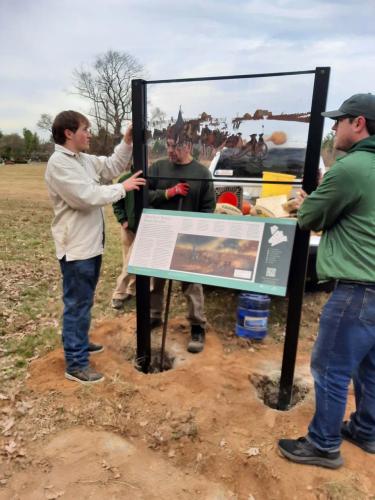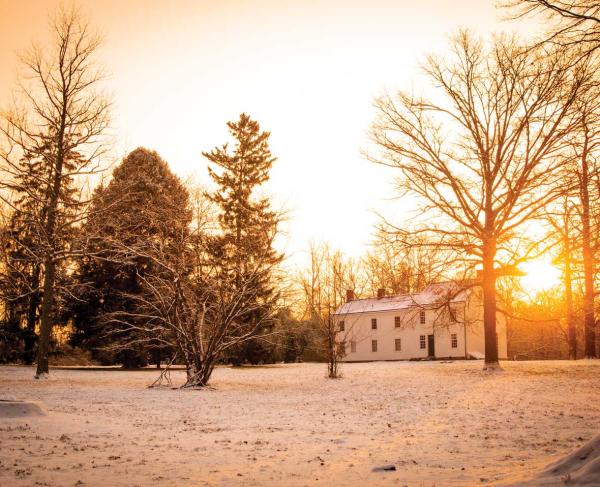Revolutionary War's Princeton Battlefield Receives Upgrade with New Historical Markers
Claire Barrett, (202) 367-1861 x7226
Colleen Cheslak-Poulton (202) 367-1861 x7234
(Princeton, N.J.) — Visitors to Princeton Battlefield State Park for the upcoming 250th anniversary of the Revolutionary War will benefit from new, tourist-friendly historical signage, thanks to a collaboration between the New Jersey Department of Environmental Protection (State Parks, Forests & Historic Sites program), the American Battlefield Trust, and the Princeton Battlefield Society. Today’s unveiling ceremony, centered around an innovative “battle window” that overlays period artwork with the modern landscape, will enable visitors to better understand this decisive moment in American history. The ceremony also marks a key milestone in ongoing efforts to upgrade the visitor experience at the park.

“We want all Americans to visit the Princeton Battlefield,” stated David N. Duncan, president of the American Battlefield Trust. “Through audacity and personal leadership, George Washington saved the American Revolution on this battlefield. Washington, riding a white steed, heroically led his men in a dramatic counterattack that broke the British lines, wasn't lifted from a Hollywood script. It really happened, right here.”
Mark Texel, administrator of State Historic Sites for the New Jersey Department of Environmental Protection John Cecil, assistant commissioner for New Jersey State Parks, Forests and Historic Sites, also referenced Princeton as a turning point in American history: “On January 3, 1777, the cause of American Independence hung in the balance at Princeton, and that pivotal moment in history deserves to be captured through the very best in 21st century interpretive techniques. This new signage will immediately enhance the experience of visitors and excite the community for the work still in progress.”
Learn More about Ongoing Efforts to Reimagine Princeton
The signage unveiled today includes 10 traditional waysides with historical content and one “battle window” that applies extracted elements from a well-known James Peale painting onto an acrylic window, allowing visitors to better grasp how battle action unfolded on the landscape. A second battle window, highlighting the British perspective and featuring a custom illustration from historical illustrator Dale Watson, plus a bronze patina map table depicting the battlefield’s topography will also be installed before year’s end. This will coincide with the December launch of a mobile tour app, including an augmented reality experience.
Wheels are already in motion for other elements of the interpretation and restoration plan. A targeted archaeological investigation by South River Heritage Consulting, led by archaeologist Wade Catts, took place throughout late summer and early fall, thanks to funding from the New Jersey Historic Trust. The field team found case shot and musket balls that confirmed troop positions, as well as more curious items, including a medallion from the 1745 Jacobite Rebellion. A LiDAR (Light Detection and Ranging) scan of the battlefield was also conducted to aid in the archaeological research prior to field work.
These efforts are preparatory for the enhancements toward which the New Jersey Legislature allocated $1.3 million over the summer. They will emphasize the battlefield’s inspiring vistas and incorporate a new park entrance, visitor orientation circle, and parking area, away from the historic center of the battlefield. Also planned are the installation of a walking path, restoration of historic tree and fence lines, the recapture of period road traces and removal of modern intrusions.
The reimagining of the visitor experience at Princeton began with the American Battlefield Trust’s acquisition of 15 acres at Maxwell’s Field. The land, essential to understanding the full scope of the battle, is directly adjacent to the state park’s current holdings. Following that purchase, the Trust secured a planning grant from the federal American Battlefield Protection Program, administered by the National Park Service. In close consultation with an array of stakeholders, this partnership produced an innovative and multi-phased interpretation and restoration plan to capitalize on the new interpretive opportunities provided that was met with enthusiastic community support. The new interpretive signage is the first step to be implemented.
The Battle of Princeton was the culmination of the Ten Crucial Days campaign, which began when General George Washington made a desperate gamble with his army – the only outcomes of which were “victory or death.” He crossed the ice-choked Delaware River on Christmas to attack Hessian troops at Trenton. He triumphed that morning, only to enter into a high-stakes game of cat and mouse that led to a second crossing of the Delaware a few days later. Finally, in the fields outside Princeton, he met a column of British Regulars in massed, pitched battle. Knowing failure would endanger all the gains made in recent days, Washington personally led a countercharge across Maxwell’s Field, where the action was thickest. When the smoke cleared, Washington was still astride his white steed, but the British line was broken and in retreat.
From a grassroots organization started by historians nearly 40 years ago, the American Battlefield Trust has grown into one of the most successful historic land preservation and education organizations in the United States. The Trust has protected nearly 60,000 acres associated with the Revolutionary War, War of 1812 and Civil War, representing 160 sites in 25 states from Massachusetts to New Mexico. Its 350,000 members and supporters believe in the power of place and the continued relevance of our shared history to modern American society. Learn more at www.battlefields.org.
###

